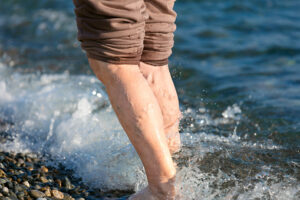Can Varicose Veins Fully Be Treated?

Varicose veins are unsightly, and in some cases, they can be extremely uncomfortable as well. Fortunately, there are many different treatments available for varicose veins, including some that are minimally invasive. How effective are these treatments? Can varicose veins ever fully be treated?
To understand the answer to this question, it’s important that you first understand how veins work and what causes varicose veins. Veins are blood vessels, of course, and all veins except the pulmonary vein are tasked with the function of carrying deoxygenated blood from the body to the heart. As different parts of the body use oxygen, they release used blood with waste products like carbon dioxide into the veins. The veins then transport that blood to the heart, which sends it to the lungs, where the waste is released, and the blood is loaded with more oxygen. It’s then the task of the arteries to carry the newly oxygenated blood throughout the body.
How do veins and arteries keep the blood flowing in the right direction? Especially in the arms and legs, one-way valves are used to prevent backward blood flow. When these valves fail to work properly, it disrupts the process of circulation. Sometimes, this causes blood to pool in veins, and that’s when a spider vein or varicose vein can develop. If you think you may have varicose or spider veins, you can perform a self-assessment by answering these questions:
- What do the veins look like? Varicose veins are bigger than 4 millimeters in diameter, and they typically bulge visibly from the leg. Spider veins usually aren’t something you can feel through the skin, and they appear as short, fine lines, clusters, or in a web-like configuration.
- What color are the veins? Varicose veins are typically blue or purple, but spider veins can also be red.
- Where are the veins located? While varicose veins are usually on the legs, spider veins are most common on the thighs, ankles, and feet, and sometimes on the face.
- What is your lifestyle like? Varicose veins are most common in people with sedentary jobs, those who don’t get much exercise, and those who are obese. They’re also common in people who spend a lot of time in one position, like standing or sitting, and in pregnant women.
- What’s your age and gender? Women and older people are often prone to varicose and spider veins.
There are many different treatment options available for varicose or spider veins. The most common method is destructive intervention, including endovenous laser treatment, radiofrequency ablation, or sclerotherapy. The purpose of all of these treatments is to disable the varicose vein so that the blood will redirect into a healthy vein.
This brings us back to the question: can varicose veins be fully treated? Technically, no. Once the valves in the veins are damaged, they can’t be repaired, and no current treatment to reverse the damage. While vein treatment is effective, some people experience the return of varicose veins after they’ve been treated. This doesn’t mean the original vein is back in operation, but that a new varicose vein has developed.
If you’re seeking the very best care for your vein and blood flow issues, trust the board-certified physicians at the Arizona Vein & Laser Institute. Using the most advanced technology, the vascular and cardiovascular surgeons at the Arizona Vein & Laser Institute provide care for all types of venous diseases. With over 40 years of experience, our team of experienced physicians can devise the right treatment plan to address your venous disease problems. For more information contact us through our website.
